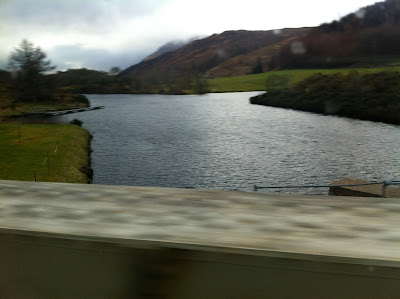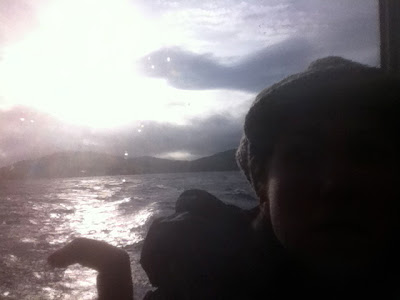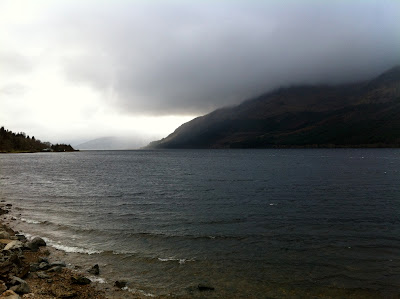I tried to watch the movie Braveheart while I was in Scotland. I had never seen it before because I have heard bad things... I am more of a Disney-happy-ending kind of movie watcher. Scary movies give me nightmares. Sad movies make me depressed. Things have to work out for the protagonist in an uplifting and, or comical way or I will not willingly watch it. But I feel like I should watch it to at least learn a little bit more about Scottish history. Plus the tour guide said it is fairly historically accurate...
I downloaded the movie rental to my itunes account. I watched it up until William Wallace's new wife gets whacked off a horse by a lance swung from the British king's guard....turned off the movie....Ok, I can better understand why the Scots hate the Brits....I waited a couple hours, then turned it back on. A few minutes into my second attempt, William Wallace's wife is tied to a pole and her throat is slashed....turn off movie for a day.
The next day I am determined. I turn Braveheart back on. There is not as much violence against women in the next segment, just a bunch of brutal non-descriptive battle scenes. I can zone this out. Ah the Scots were outnumbered but they mooned the British and used some clever tactics to outwit them. Hooray the Scots win!! Battle # 2, not going so good. Ah, the man sho was supposed to help never showed up and is in fact working along side the Brits. Battle over. Scots lose. William Wallace is left blubbering like a baby on the battlefield. Julie is left blubbering like a baby on her hotel bed.
Turning this off.
Later in my trip, I mentioned to a friend that I was watching Braveheart and they were like "oh yea, that scene where he gets castrated...." What!>? He gets castrated?! Glad I never watched the end of that one...
 |
| Ah tranquil Scotland |
On my last full day in Scotland I booked a 12 hour bus tour.... hey, I've got nothing better to do...
 |
| ...and neither do these people! |
 |
| bridge |
 |
| field |
 |
| sheep |
 |
| river |
 |
| waterfall |
 |
| rainbow |
 |
| The Highlands |
Scottish cattle:
 |
| This picture of a picture of a highland cattle.....reminds me of my little sister: |
 |
| in an endearing way |
The old bus driver picked me up wearing full Scottish garb...kilt, socks, pouch...perfect. He started off telling stories and barely stopped talking for the duration of the trip...talk about "gift of the gab."
Here are some things I learned from the old man:
Kilts from the old days looked a little bit different. During the day the Scots would wear a piece of rectangular cloth draped around like a skirt and then over the shoulder like a toga. At night they would take it off and use it like a blanket. The colors of the plaid would distinguish one family from the next. Each clan had their own colors and designs so you could tell your friends and enemies by their outfits. In their pouch, Scots would carry valuables, food, and a hip flask of whiskey. Scots would always carry two knives: one in their waistband used for fighting and the other in their sock used for eating, picking their nails, skinning rabbits etc. Currently it is against British law to carry a knife in public... unless you are a Scot dressed in a kilt and your knife is one of these special Scottish knives and it is tucked in your sock...true story.
Some educational geographical translations that I learned:
A glen is a valley. A loch is a lake. A strath is a wide glen (valley). A dow is a field. A dowry is a king's field. "Ness" added at the end of a town means the city at the mouth of the river. Inverness is a town at the mouth of the river Inver.
Then the guide went on to chat about some of the battles that occurred in Scotland way back when:
Back in 1692 an order went out to all the Scottish chiefs that they must swear an allegiance to King William by the end of the year or else they would face dire penalties if they failed to sign. Previously the Scottish chiefs were obedient to the former King James (and were appropriately termed "Jacobites"). The Jacobites had just participated in an uprising in hopes to reinstate James who at this point is exiled to France. On the way home from the uprising the Maclain clan looted the territory of the Campbell clan and stole all his livestock. The Jacobite uprising was eventually squashed by King William and he wasn't too happy about things. Now William sought to punish the Scots if they didn't convert to his team. But he did promise to let them off "Scot-free" if they pledged their allegiance to him.
The Highland chiefs sent word to exiled King James asking what they should do? James was convinced that he was close to returning to Britain to reclaim his throne, but he wasn't sure when all his wheels would be in motion. When it became apparent that this was not going to happen before the deadline, James sent orders back to Scotland authorising the chiefs to take the oath. This message reached its recipients in mid-December, in difficult winter conditions, only a few weeks before the deadline. A few managed to comply promptly but others did not, including Alastair Maclain, 12th Chief of Glencoe (a smaller group of the bigger MacDonalds), who waited until the last day before setting out to take the oath.
 |
| Near Glencoe |
On 31 December 1691 Maclain travelled to ask the governor, Colonel Hill, to administer the required oath, but Hill was not authorised to receive it and instructed MacIain to proceed quickly to make his oath before Sir Colin Campbell, sheriff of Argyll. Hill gave Maclain a letter of protection and a letter to Sir Colin asking that he receive Maclain's oath since Maclain had come to him within the allotted time. Hill also reassured MacIain that no action would be taken against him without him having the opportunity to make his case before the King.
Days after the deadline, Sir Colin Campbell (who had an ongoing rivalry with the MacDonalds) reluctantly accepted Maclain's oath. Maclain returned to his home thinking he had satisfied the spirit of the oath, and was confident there would be no action against him or his people.
Little did he know that a member of the Campbell clan who seeking revenge against the McDonalds had gotten in touch with a senior member in King William's military who was already looking forward to wiping out some Scots and destroying the clan system in anticipation of their failure to sign the oath. This guy convinces the king that the MacDonalds falsified the oath and are nothing but a bunch of riotous thieves. King William quickly passes the order to exterminate them...all of them... RIP MacDonalds of Glencoe.
More than 200 Scots were killed in the valley that day. Glencoe has since been nicknamed the Valley of Weeping. Sad
 |
| Glencoe |
In Glencoe are three extinct volcanoes nicknamed the Three Sisters:
 |
| Two of the Three Sisters |
Ben Nevis which is the highest point in Great Britain is found in the Scottish highlands:
 |
| Ben Nevis looks like a wart |
Whiskey in Gaelic translates to the "water of life."
The Great Glen of Scotland nearly cuts Scotland in two and is made up of 3 natural lochs including Loch Lochy, Loch Ness, and Loch Oich. Manmade canals join the three lochs.
 |
| Loch Lochy |
 |
| the canal |
The more famous of the three, the Loch Ness, is the second largest Scottish loch by surface area, but it is in fact the deepest loch, making it the largest loch by volume. It is over 800 feet deep (at least at the deepest recorded) making it deeper than the North Sea. The water flowing into the loch from the River Ness is very murky due to it's high peat content. The peaty water makes it barely possible to see past 10 feet when under water. If you were 12 feet under water, you would not even be able to see the sunlight at the water's surface. (That's what they say anyway, I didn't try it).
 |
| Me at the Loch Ness |
 |
| See any monsters? |
 |
| Nellie sighting!! |
The murky water setting has enabled the myth of the Loch Ness monster to grow. Sightings of "Nessie" have dated back to the 6th century where Saint Columba encountered some sailors on the shore of Loch Ness who were burying their friend that they claim had fallen overboard and been eaten alive by this monster. The Saint proceeded to throw his assistant into the lake and told him to swim to the other shore. Once the monster was about to attack the assistant, Saint Columba made the sign of the cross and calmly told the moster not to attack the man but to go back to where he came from.... and the monster obliged. ...or so the story goes.
 |
| Barney? |
Nontheless many other people have reported Nessie sightings in the past 100 years. Few photos have been taken and many expeditions have been undertaken, but none of them have turned up any conclusive evidence. ..
 |
| This old photo was claimed to have been taken at the Loch Ness. Doubters have argued it is a submerged swimming elephant sticking his trunk out of the water. I don't know about that one. |
 |
| This grainy photo was taken underwater and is supposedly the head and neck of the monster. |
 |
| This one is supposed to be the horned head of a monster? Doubters say it is a piece of wood? I'm going to have to go with an old rock on this one. |
 |
| Nellie and I hanging out |
Even if the moster doesn't exit, the Loch Ness is still a lovely place to visit. During my trip I took an hour long boat tour around the loch exploring it's shorelines and the Urquhart castle, looking for signs of a sea monster. ....
 |
| hmm wonder what caused that ripple? |
During the tour I decided to have a beer. I asked the boat bartender for one of the tourist trap pints... Can I have one of those Nellie beers? She proceeded to give me shit for the next 15 minutes that it's Nessie not Nellie!! Damn...I knew that one...
The Loch Ness is also famous for other reasons. For instance on a Sunday in 1952 a fellow by the name of John Cobb attempted to break the water speed record on the Loch Ness. He was in a crusader boat going 206mph. When he crossed the 1 mile finish line his boat exploded and he was blown to bits. Scots really liked John Cobb, so they never worked on a Sunday since. They also erected memorial kiln (a pile of rocks) in his honor.
During World War II in December of 1940 a bomber plane crash landed on Loch Ness. The plane sunk, but the passengers were rescued by a suspicious eel like serpent in the night. Just kidding, they climbed on board their dinghy and rowed to shore. In 1985 a fleet of boats set out on the Loch Ness equipped with sonar to search for Nessie. They didn't find her, but they did find the intact sunken bomber. They took it to England to have it fixed up and to this day it is one of the only bombers of its kind still in flying condition.
Other Scottish tidbits:
- Andrew Carnegie was a famous Scot.
- So was Sean Connery who was born in Edinburgh and his first job was a milk man at the university.
- John Muir, the reason we have a National Park Service, was a Scot.
- St. Patrick, the patron saint of Ireland, was said to have been born in Scotland in 410, before going to Ireland at the age of 22.
- Sir Walter Scott and Robert Louis Stevenson are famous Scottish authors and all around Scotland enthusiasts.
- The first edition of "Encyclopedia Britannica" was published by the Scot, William Smellie...poor guy......too good not to make into the title....
- And to my great surprise, as an added bonus there are actually two famous Scottish William Smellies. The other is known as "the father of British midwifery." If I was pregnant, I would not want to go to Dr. Smellie....just saying.
And my favorite part of any tour? The jokes:
- Did you hear about the Scot who rented water skis?
- He returned them because he couldn't find any sloping water to ski down.
drum-drum-cymbal













